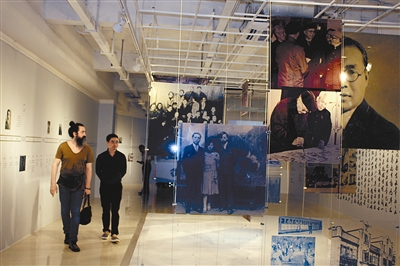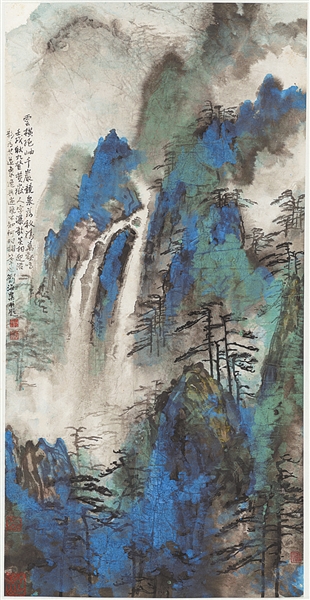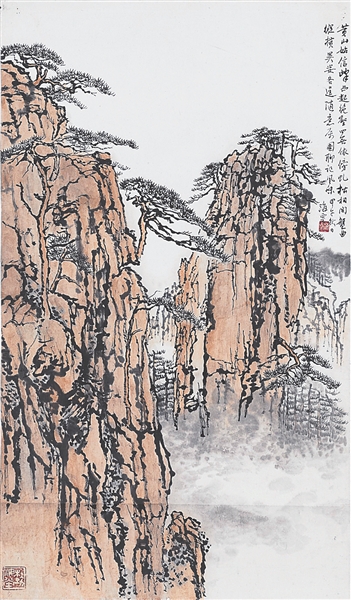

Visitors at an exhibition that honors Liu Haisu at Artron Art Gallery yesterday.Li Dan

Chinese painting: Mountain Clouds and Pines File photos

Chinese painting: Shixin Peak of the Yellow Mountain (1954)

Oil painting: Girl Wrapped in Fur (1919)
Debra Li
debra_lidan@163.com
MORE than a century has passed since 17-year-old Liu Haisu founded the first modern school of fine arts in China with some friends. But we haven’t gone much further in art education, according to Wan Jie, president of the Shenzhen-based cultural company Artron Group.
“My parents, I and my child haven’t learned much about art or art history in school,” he said at the opening of an exhibition dedicated to Liu yesterday. “I hope this exhibition helps the public understand how Liu and his contemporary masters had made efforts to enlighten the Chinese people on fine arts.”
To honor the 120th anniversary of Liu Haisu’s birth, the exhibition is being held at Artron Art Gallery in Futian. It consists of introductions to the artist’s life, the books he wrote and compiled for his students, as well as 20 of his original paintings.
“It’s an emotional experience to see the pictures and textbooks that record my father’s life as a young man,” said Liu Qiu, the son of the late master. “It’s important to learn about the background of their time to understand my father’s paintings and the changes in his style.”
An oil painting depicting a vase of sunflowers, one of Liu’s early works, clearly reflects influence from Van Gogh. Another portrait of a naked woman mirrors the style of Gauguin. However, he formed his own unique style drawing from Chinese painting traditions later.
“You can tell from an oil painting depicting the landscape of the Yellow Mountain (done in 1962) that it is definitely and uniquely my father’s style,” the artist’s son said.
The exhibition, a highlight of the ICIF events in Futian District, is held in collaboration with Liu Haisu Art Museum in Shanghai.
The museum’s curator Zhu Gang said Liu had achievements in many respects: oil painting, Chinese painting and art education. Liu promoted the idea of painting about real life and using real people as models. He also promoted the practice of mixing girls and boys in a class. Zhu noted Liu was also a patriot. “Liu went to Southeast Asia to raise money for the Chinese army during WWII, and he donated all his paintings to our museum, a public institution, on his death.”
Set up on the second floor of Artron gallery, the exhibition also displays the textbooks compiled by Liu’s contemporaries such as Feng Zikai. One room is set up to look like Liu’s art classroom.
To better understand the influence of Liu’s early works, visitors can observe another exhibition featuring the works of post-impressionists and Fauve artists on the third floor of the gallery.
Background
Liu Haisu (March 16, 1896-Aug. 7, 1994) was a prominent 20th-century Chinese painter and a noted art educator. He excelled in both Chinese and oil painting.
Harboring a love for painting since his youth, Liu learned Western painting at a Shanghai school directed by Zhou Xiang when he was 14. In 1912, he founded the first school of fine arts in modern China with some friends.
During a career that spanned eight decades, Liu wrote books, introducing Western art to China and Chinese painting to the outside world. He toured Japan and Europe extensively in the 1920s and 1930s, having his painting style influenced by impressionism. His oil paintings are characterized by a unique style that combines Chinese painting traditions and inspirations from Cézanne, Gauguin and Van Gogh. During the Cultural Revolution, Liu focused on practicing Chinese paintings and in his later years, Liu traveled many times to the Yellow Mountain trying to capture the landscape in his paintings. His Chinese paintings are distinct from traditional artists with a bold use of shades of green, reflecting influences from impressionism.
His representative works include oil paintings of historical buildings in Beijing and Chinese paintings of the landscape of the Yellow Mountain.